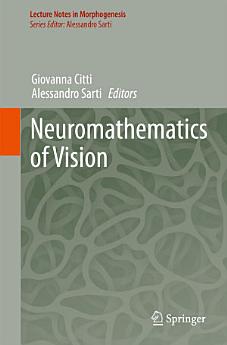Neuromathematics of Vision
Giovanna Citti · Alessandro Sarti
feb 2014 · Springer Science & Business Media
eBook
367
Páginas
reportLas valoraciones y las reseñas no se verifican. Más información
Información sobre este eBook
This book is devoted to the study of the functional architecture of the visual cortex. Its geometrical structure is the differential geometry of the connectivity between neural cells. This connectivity is building and shaping the hidden brain structures underlying visual perception. The story of the problem runs over the last 30 years, since the discovery of Hubel and Wiesel of the modular structure of the primary visual cortex, and slowly cams towards a theoretical understanding of the experimental data on what we now know as functional architecture of the primary visual cortex.
Experimental data comes from several domains: neurophysiology, phenomenology of perception and neurocognitive imaging. Imaging techniques like functional MRI and diffusion tensor MRI allow to deepen the study of cortical structures. Due to this variety of experimental data, neuromathematematics deals with modelling both cortical structures and perceptual spaces.
From the mathematical point of view, neuromathematical call for new instruments of pure mathematics: sub-Riemannian geometry models horizontal connectivity, harmonic analysis in non commutative groups allows to understand pinwheels structure, as well as non-linear dimensionality reduction is at the base of many neural morphologies and possibly of the emergence of perceptual units. But at the center of the neurogeometry is the problem of harmonizing contemporary mathematical instruments with neurophysiological findings and phenomenological experiments in an unitary science of vision.
The contributions to this book come from the very founders of the discipline.
Experimental data comes from several domains: neurophysiology, phenomenology of perception and neurocognitive imaging. Imaging techniques like functional MRI and diffusion tensor MRI allow to deepen the study of cortical structures. Due to this variety of experimental data, neuromathematematics deals with modelling both cortical structures and perceptual spaces.
From the mathematical point of view, neuromathematical call for new instruments of pure mathematics: sub-Riemannian geometry models horizontal connectivity, harmonic analysis in non commutative groups allows to understand pinwheels structure, as well as non-linear dimensionality reduction is at the base of many neural morphologies and possibly of the emergence of perceptual units. But at the center of the neurogeometry is the problem of harmonizing contemporary mathematical instruments with neurophysiological findings and phenomenological experiments in an unitary science of vision.
The contributions to this book come from the very founders of the discipline.
Valorar este eBook
Danos tu opinión.
Información sobre cómo leer
Smartphones y tablets
Instala la aplicación Google Play Libros para Android y iPad/iPhone. Se sincroniza automáticamente con tu cuenta y te permite leer contenido online o sin conexión estés donde estés.
Ordenadores portátiles y de escritorio
Puedes usar el navegador web del ordenador para escuchar audiolibros que hayas comprado en Google Play.
eReaders y otros dispositivos
Para leer en dispositivos de tinta electrónica, como los lectores de libros electrónicos de Kobo, es necesario descargar un archivo y transferirlo al dispositivo. Sigue las instrucciones detalladas del Centro de Ayuda para transferir archivos a lectores de libros electrónicos compatibles.





